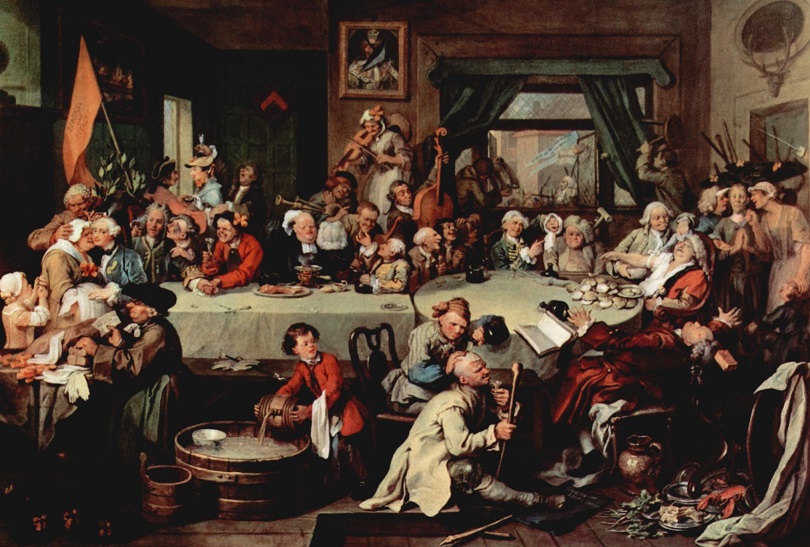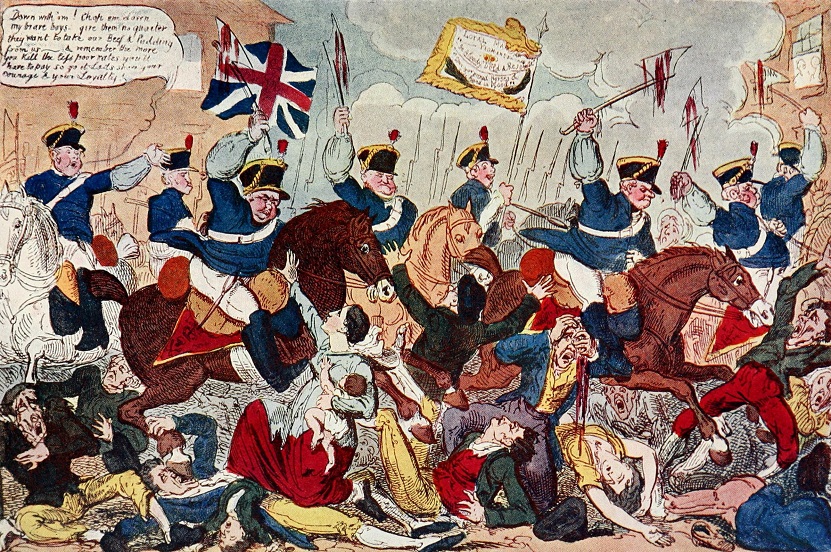
Government in 18th Century England

Introduction
In the eighteenth century, Britain was not a democracy. Out of a population of less than 10 million people, only about 250,000 men were allowed to vote. Women were not allowed to vote. Huge towns such as Manchester and Birmingham had no MPs. Yet some places which had MPs had very few voters – they were called 'rotten boroughs'.
Parliament did not represent the people – it represented the rich.
Bribery of MPs was common. Have you heard the phrases `before you can say Jack Robinson', and 'a golden handshake'? Mr Robinson was King George III's agent. He could (quickly and easily) get MPs to vote any way the king wanted. One way he did this was by the 'golden handshake'. As the MPs Went out to cast their votes, Robinson would be waiting for them at the door. As they passed, he would shake their hands – but in his palm there would be some gold coins.
After you have studied this webpage, answer the question sheet by clicking on the 'Time to Work' icon at the top of the page.
Links:
The following websites will help you research further:
18th Century Government:
•
History Learning website
•
BBC website on government before the Great Reform Act of 1832
• Hogarth's humorous painting showing polling in the 1754 election
• A detailed website on the Pentrich Rebellion
• A detailed website on the Peterloo Massacre
![]()
1 Hogarth's Election Dinner
Elections were held in public, so everybody could see who you were voting for. Candidates bribed and bullied the electors. This painting by Hogarth is called
The Election Dinner. The painting was inspired by actual events
during the General Election of 1754.
Study the picture. In what different ways are the candidates trying to influence the voters?

Things to notice:
• The candidate
on the left at the head of the table;he is
having to kiss thw wife of one of the voters
•
A girl steals his ring from his finger.
• To the candidate's left sits his political agent (Sir Commodity Taxem), making
promises to two revolting voters.
• Behind the agent, a man gives a gift to a prostitute.
• A parson is heating up a joint of venison.
• A group of players entertains the voters.
• One gentleman earns the votes of the imbeciles by making faces with his hand.
• One voter has eaten so many oysters he has collapsed and is being bled by a doctor.
• An honest tailor tries to refuse a bribe, but his wife is
cursing him.
• Outside the window, the opposition are holding a march, while the candidate's supporters throw chairs, and pour a vat of urine out of the window on them.
• A battle is going on at the door, and a brick thrown through the window has knocked the lawyer off his seat.
• In the foreground, the butcher rubs gin into the wound of another voter, who has had his head split open.
• There are several bottles of wine on the table, and a boy mixes a huge vat of punch.
• On the left, in front of the table, Abel Squat, a dealer, packs up gloves, ribbons and stockings to send as gifts to voters.
• It is impossible to tell the two parties apart. Both flags read 'Liberty'.
Government – Continued
In 1789, the French people revolted against their government. Before long, the new revolutionary government had sent to the guillotine the king, the queen, and any nobles and clergy they could catch.
The French Revolution scared the British government. During the eighteenth century, skilled workmen had started to combine (join together) to try to improve their working conditions; these were the first trade unions. In 1799 the government passed laws – called the Combination Acts – to stop people combining to campaign for better wages. The Combination Acts, in effect, banned trade unions.
Even after 1815, when the French were defeated at the battle of Waterloo, the government was terrified that there was going to be a revolution. In December 1816 there were riots in London. In January 1817 a man threw a stone at the Prince Regent's carriage. Parliament thought these events were the start of a revolution. In March 1817, it suspended Habeas Corpus (the law which stops people being imprisoned without a trial).
This did not stop the unrest. In March 1817, the poor people of Manchester planned a hunger march to London. They were called the Blanketeers, because each man carried a blanket to sleep in. There were only a few hundred marchers, and they turned back when they were told to – but the people of London thought that the entire population of Lancashire was coming down to London to murder them.
Oliver the Spy
On 9 June 1817, there was a rebellion. The rebels met at Pentrich, in Derbyshire, and marched off to attack Nottingham.
The Pentrich rebels believed that they were part of a massive rebellion. But, although they marched all night, they did not meet any other rebels. All they met, in the morning, was a small party of soldiers. Only then did they realise that they were alone. At this point they ran away, but they were easily captured; 23 of them were found guilty of treason. Most of the 23 were transported to Australia, but four were hanged.
The Leeds Mercury newspaper revealed soon afterwards that the rebellion had been organised by a man called William Oliver – 'Oliver the Spy'.
Oliver was a failed builder. He had been going round the north of England, posing as a rebel leader from London. In every town he had told the workers that everyone else was ready for a revolution; they were just waiting for that town to rebel. The Pentrich men were the only people who had believed him.
The scandalous part of these events was that William Oliver had been in the pay of the British government. He was a spy, paid by the government to cause trouble, and then to betray the people he had encouraged to rebel.
The government had tricked people into rebelling, so that it could arrest and execute them as en example to others.
The Peterloo Massacre
Unrest continued during 1818 and 1819. The leaders were called 'Radicals', because they wanted a radical (root) change in how Britain was governed. They thought there should be a general election every year, and they wanted all men to be allowed to vote.
On 16 August 1819, a crowd of 50,000 people gathered at St Peter's Fields in Manchester to hear a speech by Mr Henry Hunt, the Radical leader. They carried banners saying 'Unity and Strength'. Everybody was wearing their Sunday best. Many men had brought their wives and families with them. One group of men arrived marching, in perfect step; they had been practising for weeks on the moors, to show the world how orderly and well-behaved working men could be. Henry Hunt's first words were to beg the crowd to stay silent and not to cause any trouble.
The authorities waited until Henry Hunt had started speaking. Then they sent in the cavalry. Some of the soldiers were drunk and lost control of their horses. Then, as the crowd tried to get away, they lashed out with their swords. Eleven people were killed and over 400 injured. The event became known as the Peterloo Massacre, a sarcastic reference to the battle of Waterloo which had taken place only four years earlier.
The Six Acts
Far from shaming the government, Peterloo convinced it that revolution was just around the corner. In 1819 it passed six acts of parliament designed to stop all chance of rebellion.
The Six Acts said
that:
• No group of people could practise marching.
• Meetings of more than 50 people needed the permission of the local magistrates. Only local people could attend, and flags and banners were forbidden.
• Trials of troublemakers should take place quickly.
• Any house could be searched if it was suspected that it contained weapons.
• There would be strict punishments for the writers of anything criticising the government.
• Stamp duty had to be paid on all newspapers (this made them too expensive for ordinary people).
In 1820, Britain was not a free country.
2 The Peterloo Massacre
A cartoon of the Peterloo Massacre. Did the cartoonist support the government or the protestors?
